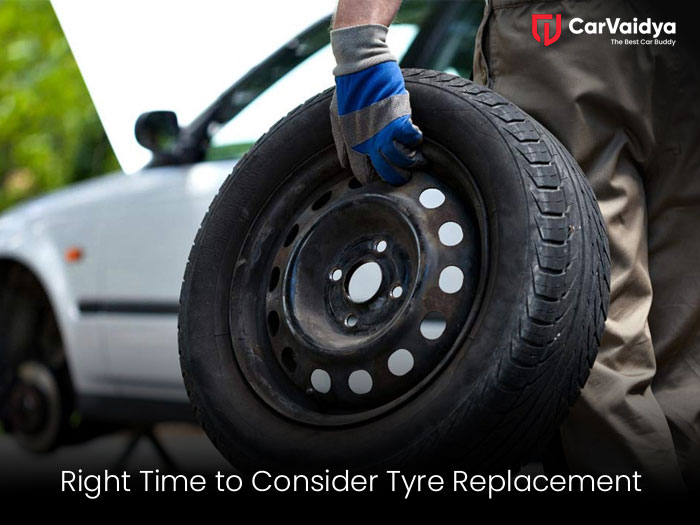When is the Right Time to Consider Tyre Replacement?


 By CarVaidya
By CarVaidyaTyres are an essential component of any vehicle, directly impacting safety, fuel efficiency, and overall driving performance. Regularly checking and replacing tyres when necessary is crucial for maintaining optimal vehicle function and ensuring driver and passenger safety. But how do you know when it's the right time to consider tyre replacement? This comprehensive guide explores various indicators and factors that signal it’s time for new tyres.
One of the most obvious signs that tyres need to be replaced is tread wear. The tread on a tyre is what provides traction, and over time, it wears down due to constant contact with the road. The minimum legal tread depth in many countries is 1.6 millimeters (about 2/32 of an inch). However, for optimal safety, especially in wet conditions, it’s recommended to replace tyres when the tread depth reaches 3 millimeters.
Tread Wear Indicators: Most tyres come with tread wear indicators, small raised bars that run perpendicular to the tread. When the tread wears down to the level of these bars, it’s a clear sign that the tyres need replacement. Another common method is the "penny test." Insert a penny into the tread with Lincoln's head upside down. If you can see the top of Lincoln's head, the tread is too shallow, and it's time for new tyres.
Even if tyres appear to have adequate tread depth, they should be replaced after a certain number of years. Tyre manufacturers generally recommend replacing tyres every six to ten years, regardless of tread wear. This is because tyres deteriorate over time due to exposure to elements such as sunlight, ozone, and temperature fluctuations, which can cause the rubber to harden and lose its effectiveness.
Checking the Age: You can determine the age of your tyres by checking the DOT code on the sidewall. The last four digits represent the week and year the tyre was manufactured. For example, a tyre with a DOT code ending in "2318" was made in the 23rd week of 2018.
Cracks in the tyre sidewall or tread can indicate that the rubber is breaking down. These cracks, also known as dry rot, can lead to tyre failure. Bulges or blisters on the tyre surface suggest that the tyre's internal structure has been compromised. Both conditions can result from impact damage, such as hitting a pothole or curb, and necessitate immediate tyre replacement.
If you experience unusual vibration or thumping while driving, it could indicate an internal problem with your tyres. This could be due to a variety of issues, including misalignment, imbalanced tyres, or a separated tread. If vibration persists after balancing and alignment checks, it’s wise to inspect the tyres thoroughly, as internal damage may not be immediately visible but can significantly impact safety.
Tyres should wear evenly across the tread if they are properly aligned, balanced, and inflated. Uneven wear can result from improper alignment, over-inflation, under-inflation, or worn suspension components. Regularly rotating your tyres can help promote even wear. However, if you notice uneven wear patterns, it’s essential to address the underlying issue and consider replacing the affected tyres.
If a tyre requires frequent inflation or loses air rapidly, it could be a sign of a slow puncture, a faulty valve, or damage to the tyre bead. Continuous air loss can lead to under-inflation, which not only reduces fuel efficiency but also increases the risk of a blowout. In such cases, it’s important to have the tyre inspected by a professional and replace it if necessary.
Diminished handling, braking, or acceleration performance can also be indicators that your tyres are no longer in good condition. This can be particularly noticeable in adverse weather conditions, where the tyres' ability to grip the road is compromised. If your vehicle feels less responsive or takes longer to stop, it might be time to consider new tyres.
Excessive tyre noise can be a sign of uneven wear, cupping (a type of wear pattern), or structural issues within the tyre. While some noise can be normal, especially on rough surfaces, a significant increase in noise level warrants an inspection and possible replacement of the tyres.
If you live in a region with extreme seasonal changes, it’s important to switch between summer and winter tyres accordingly. Winter tyres are designed to perform better in cold temperatures and snowy conditions, while summer tyres offer better performance in warmer weather. Using tyres that are not suitable for the current season can lead to decreased performance and increased wear.
Always follow the vehicle manufacturer’s recommendations regarding tyre specifications and maintenance. The owner's manual provides guidance on the correct type, size, and pressure of tyres for your vehicle. Adhering to these guidelines helps ensure optimal performance and safety.
Replacing tyres is a crucial aspect of vehicle maintenance that directly impacts safety and performance. By regularly inspecting your tyres for tread wear, age, cracks, bulges, vibration, uneven wear, frequent air loss, performance issues, noise, and seasonal suitability, you can determine when it’s the right time for replacement. Following these guidelines not only enhances your driving experience but also ensures that you and your passengers remain safe on the road.
Remember, when in doubt, consult a professional. A trusted mechanic or tyre specialist can provide valuable insights and help you make informed decisions about your tyres. Investing in high-quality tyres and replacing them when necessary is an investment in your safety and the longevity of your vehicle.
Enhancing your driving experience: installing a sunroof in your car


0 Comments